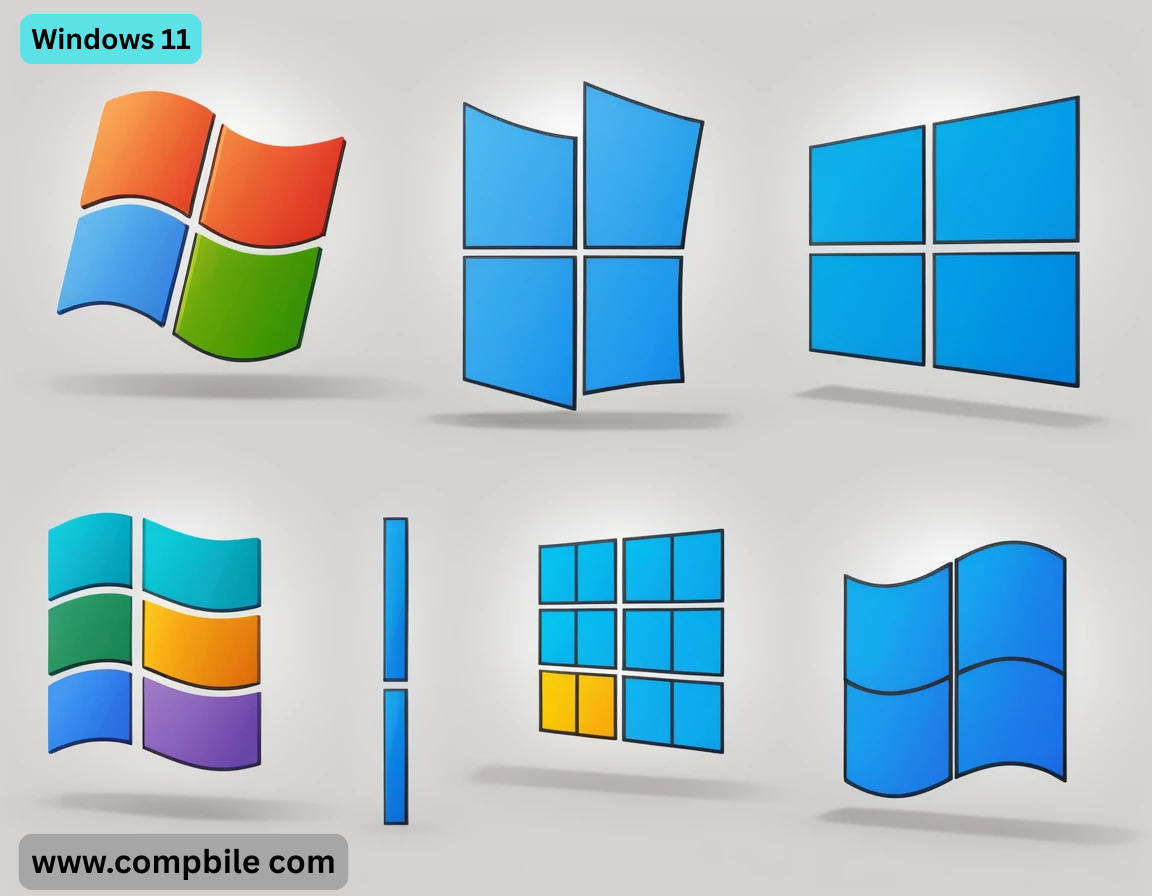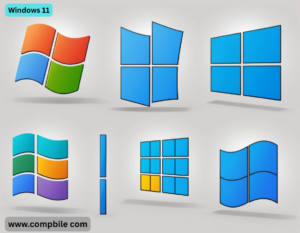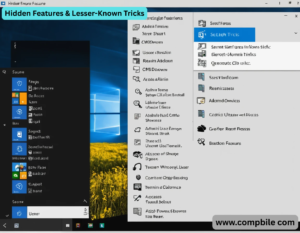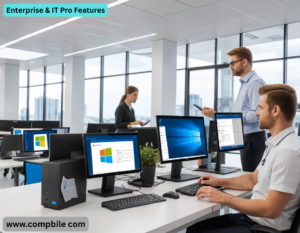Windows 11 Windows 11 introduces a refreshed design, improved performance, and new features aimed at enhancing productivity and user experience.
Redesigned UI (Fluent Design)
- Centered Start Menu and Taskbar
- Rounded corners for windows and menus
- New animations and transparency effects
Snap Layouts & Snap Groups
- Improved multitasking with predefined window arrangement options
- Hover over the maximize button to see layout choices
Microsoft Store Overhaul
- Faster and more curated app store
- Support for Android apps (via Amazon App store or sideloading)
Widgets Panel
- Personalized news, weather, calendar, and task updates
- AI-powered content suggestions (powered by Microsoft Start)
Gaming Enhancements
- Direct Storage (faster game load times with NVME SSDs)
- Auto HDR (improves color range in supported games)
Xbox Game Pass integration
- Virtual Desktops & Multitasking
- Customizable virtual desktops (like macOS Spaces)
- Better multiple monitor support
- Microsoft Teams Integration
- Built-in Chat feature (replacing Skype)
- Quick access for video calls and messaging
Performance & Security
- TPM 2.0 requirement (for enhanced security)
- Secure Boot and hardware-based security
- Better efficiency for battery life on laptops
- Android App Support (via Amazon App store)
- Run select Android apps natively (limited to certain regions)
Updates & Support
- Smaller, more frequent updates (like Windows 10)
- Annual major updates (e.g., Windows 11 22H2, 23H2)
System Requirements for Windows 11:
Component Minimum Requirement
CPU 64-bit, 1 GHz+, 2+ cores (Compatible Intel/AMD/Qualcomm)
RAM 4 GB (8 GB recommended)
Storage 64 GB+
TPM Trusted Platform Module 2.0
Graphics DirectX 12 compatible / WDDM 2.x
Display 720p, >9″ diagonal, 8-bit color
Secure Boot Required
UEFI Firmware Required
Note: Some older PCs may not meet the TPM 2.0 requirement, but workarounds exist (at your own risk).
Hidden Features & Lesser-Known Tricks
Secret Start Menu Layouts
- Right-click the Start button → “Windows Terminal” (Admin/User) for quick PowerShell/CMD access.
- Press Win + X + U → Quickly shut down, restart, or sleep.
Enhanced Right-Click Menu
- Shift + Right-click → Shows the old-style context menu with more options.
- Ctrl + Shift + Esc → Directly opens Task Manager (no Ctrl +Alt +Del needed).
Live Captions (Accessibility)
- Win + Ctrl + L → Auto-generates captions for any audio (even local videos).
- Dynamic Refresh Rate (for Supported Displays)
- Settings > System > Display > Advanced > Dynamic Refresh Rate (saves battery on laptops).
God Mode (Classic Hack Still Works)
Strict Hardware Requirements
- Many users were upset over TPM 2.0 and Secure Boot blocking older PCs.
Removed Features
- No more Live Tiles (from Windows 10).
- Taskbar limitations: No drag-and-drop, can’t move to side/top of screen.
Ads in Start Menu
- Microsoft pushes recommended apps/settings (can be disabled in Settings > Personalization > Start).
Forced Microsoft Account
- Home edition requires an internet connection + MS account during setup (pro versions allow local accounts).
3. Advanced Performance Tweaks
Reduce Animations
- Settings > Accessibility > Visual Effects → Turn off animations.
- Disable VBS (Virtualization-Based Security)
- May improve gaming performance (but reduces security):
- Disable via: Windows Security > Device Security > Core Isolation > Memory Integrity (Off).
Optimize Storage
- Win + R → clean MGR → Clean up system files (including Windows Update cache).
- Use Storage Sense (Settings > System > Storage) to auto-delete temp files.
4. Windows 11 for Power Users
- WSL (Windows Subsystem for Linux) Improvements
- Supports GUI Linux apps (e.g., GIMP, Firefox) via WSLG.
Hyper-V & Sandbox
- Built-in virtual machine support (enable in “Turn Windows features on/off”).
- Windows Sandbox → Isolated temporary desktop for testing unsafe apps.
Future Updates (2024 & Beyond)
- Windows 11 24H2 (Expected Fall 2024)
- “AI Explorer” → AI-powered timeline/search across all apps.
- Faster updates with “Hot Patching” (no restarts for some updates).
- Improved ARM support (for Snapdragon X Elite laptops).
Windows 12 Rumors (2025?)
- Microsoft may shift to a 3-year release cycle, with Win12 focusing on cloud/AI integration.
6. Should You Upgrade?
Good for: Avoid if:
New hardware (12th Gen Intel+/Ryzen 6000+) You have an old PC without TPM 2.0
Gamers (Direct Storage, Auto HDR) You rely on drag-and-drop taskbar
Touchscreen/2-in-1 devices You prefer Windows 10’s UI
Developers (WSL2, Android apps) You need long-term stability
Kernel & Low-Level Changes
- Hybrid CPU Scheduling (“Thread Director”)
- Windows 11 is optimized for Intel 12th Gen+ (Alder Lake) and Ryzen 6000+ hybrid CPUs (P-cores + E-cores).
- The scheduler prioritizes foreground apps on Performance cores while background tasks use Efficiency cores.
2. Enterprise & IT Pro Features
- Windows 365 Integration (Cloud PC)
- Requires Azure AD + Intune for management.
- Granular Control Over Feature Updates
- New “Update Compliance” policies in Intune allow:
- Pausing updates for 60 days (vs. 35 in Win10).
- Targeted rollouts (ring-based deployments).
TPM 2.0 + Pluton Security Chip
- Microsoft Pluton (in newer CPUs like Ryzen 6000+) acts as a hardware root-of-trust.
- Stores encryption keys inside the CPU (not in the TPM chip).
Kernel DMA Protection
- Blocks Thunderbolt DMA attacks (like PCI Leech).
- Requires UEFI + VT-d/AMD-Vi support.
Smart App Control (SAC)
- AI-driven application whitelisting (blocks unsigned/unknown EXEs).
- Can only be disabled during clean install (not reversible afterward).
- Extreme Customization (At Your Own Risk)
Replace Explorer with Open-Shell
- Use Open-Shell-Mod to restore Windows 7-style Start Menu.
- Windows 11 Internals (For Developers)
Win UI 3 vs. UWP vs. Win32
- Win UI 3 is now the default UI framework (replacing UWP).
- Backwards-compatible with Win32/WPF via XAML Islands.
- WDDM 3.1 GPU Driver Model
- Supports DirectX 12 Ultimate features:
Mesh SHADERS
- Variable Rate Shading (VRS)
- Sampler Feedback
The Future: What’s Next?
- Windows 11 LTSC (2024)
- “Core PC” Modular OS (Leaked)
- Microsoft is testing a state-separated OS (like Chrome OS) for instant updates/resets.
- Full Win32-on-ARM Emulation
- Qualcomm X Elite chips will run x86 apps at near-native speed.
Kernel & System Architecture
- Memory Management Changes
- Segment Heap Adoption (replacing legacy heap):
- 30-45% memory reduction for Win32 apps
- HVCI (Hypervisor-Protected Code Integrity):
- Uses EPT to enforce W^X (Write XOR Execute)
- Bypass techniques via CET shadow stacks
5. Debugging & Reverse Engineering
- Win DBG New Commands
- Analyze thread director decisions
- Dump VBS security contexts
- Driver framework inspection
10. Future Roadmap (2025+)
- Projected Features
- AI Copilot Runtime (NPU-accelerated)
- Win32onARM64 JIT Re compiler
- Fully Modular Windows Core
TPM 2.0 PCR Extend Sequence
- Boot process extends PCRs in this order:
- PCR 0: CRTM + Firmware
- PCR 2: Extended Firmware
- PCR 4: Boot Manager
- PCR 11: BitLocker Unlock
- PCR 18: Kernel Integrity Checks
Secure Boot & TPM: The Hidden PCRs
- Beyond PCR 0-23: Microsoft’s Custom PCRs
- Windows 11 extends undocumented PCRs for Measured Boot:
- PCR 28: Windows Defender ELAM (Early Launch Anti-Malware)
- PCR 29: Secure Kernel (VBS measurements)
- PCR 30: Pluton Firmware (Microsoft’s secure co-processor)
Hyper-V & VBS: The Dark Side of Virtualization
- Undocumented Hyper calls (Hyper-V Backdoor)
- Direct Storage & GPU Secrets
- NVME Priority Bands (Beyond Documentation)
- Windows 11 assigns 6 priority bands for Direct Storage:
Band Purpose
0 OS Critical (MMIO)
1 Game Assets (RT)
2 Background Downloads
3 Prefetch Data
4 User Files
5 Low-Priority I/O
The Future: Windows 12 Leaks (2025)
- “Core PC” (Fully Modular Windows)
- State Separation: OS partitions into read-only / writable sections.
- Instant Reset: Like Chromebooks, but for Windows.
- AI Copilot in Kernel Mode
- NPU-accelerated system calls.
- Predictive memory preloading.
Get article on pdf file….Click now
………..Windows 11……..




